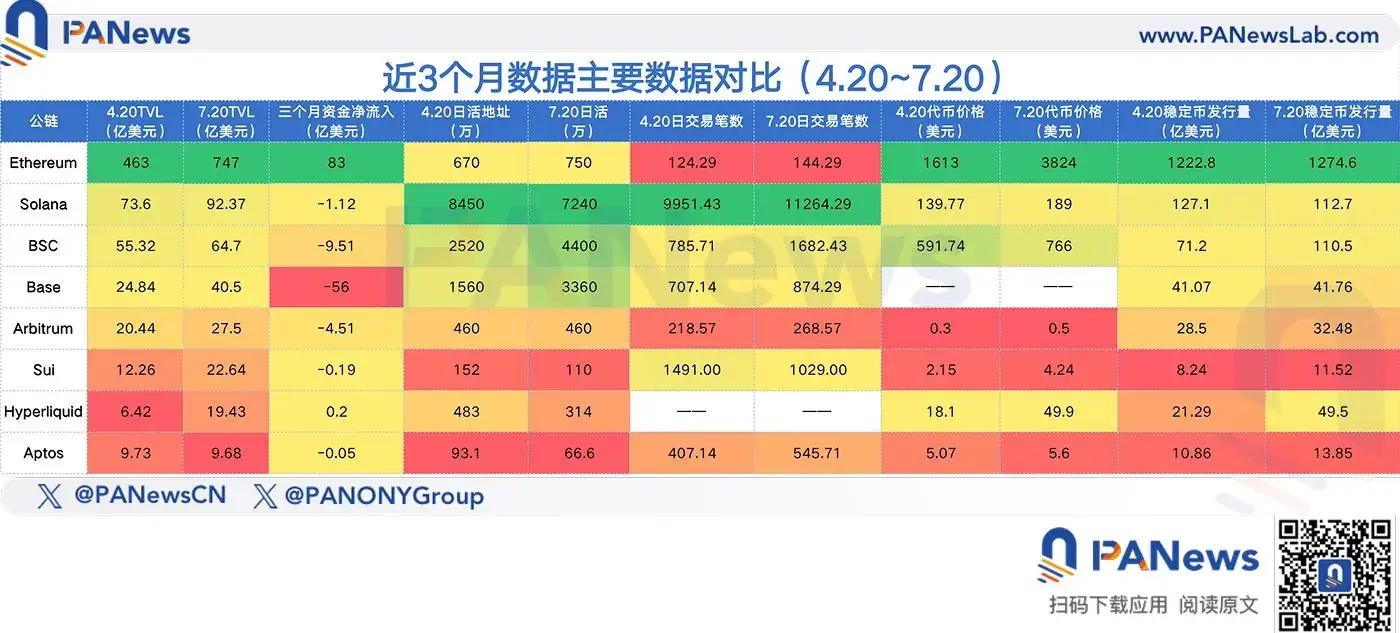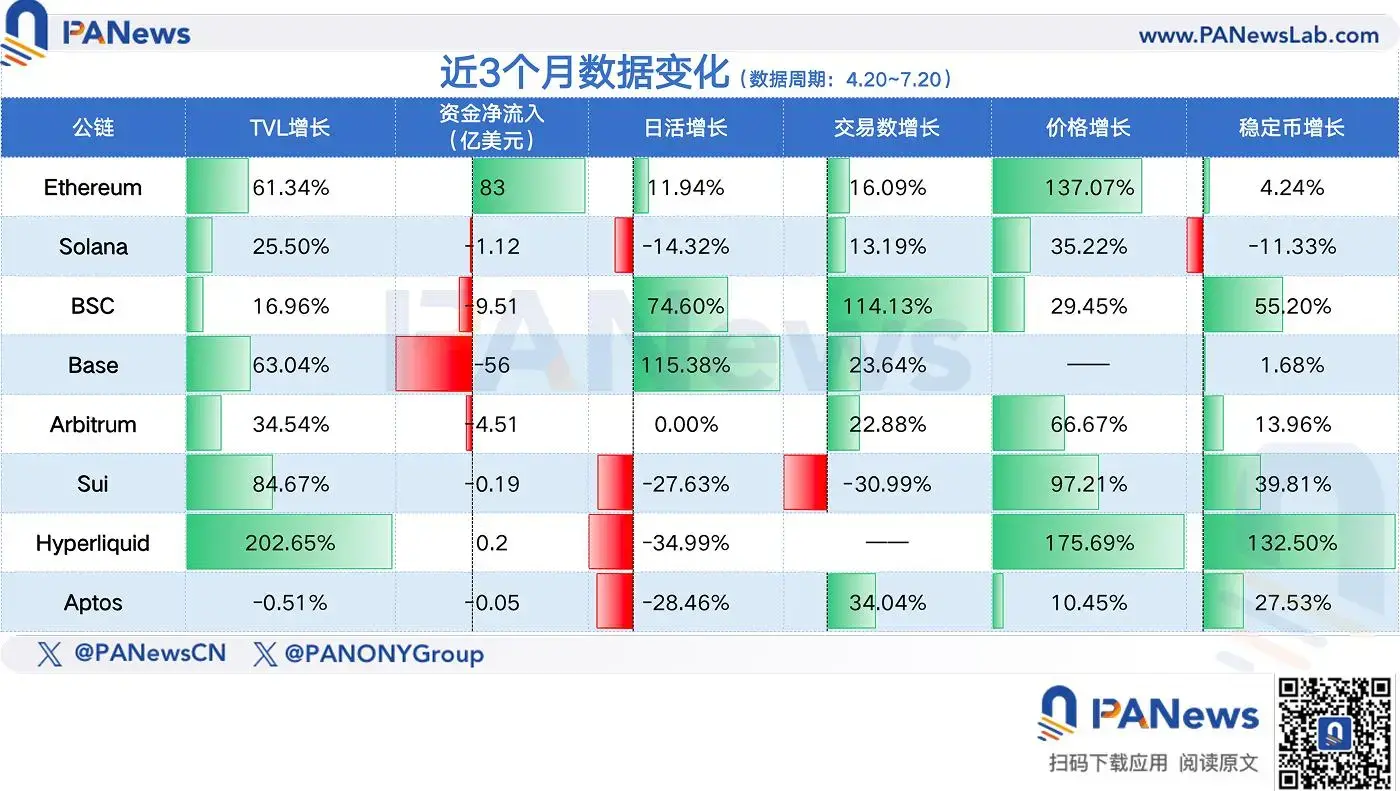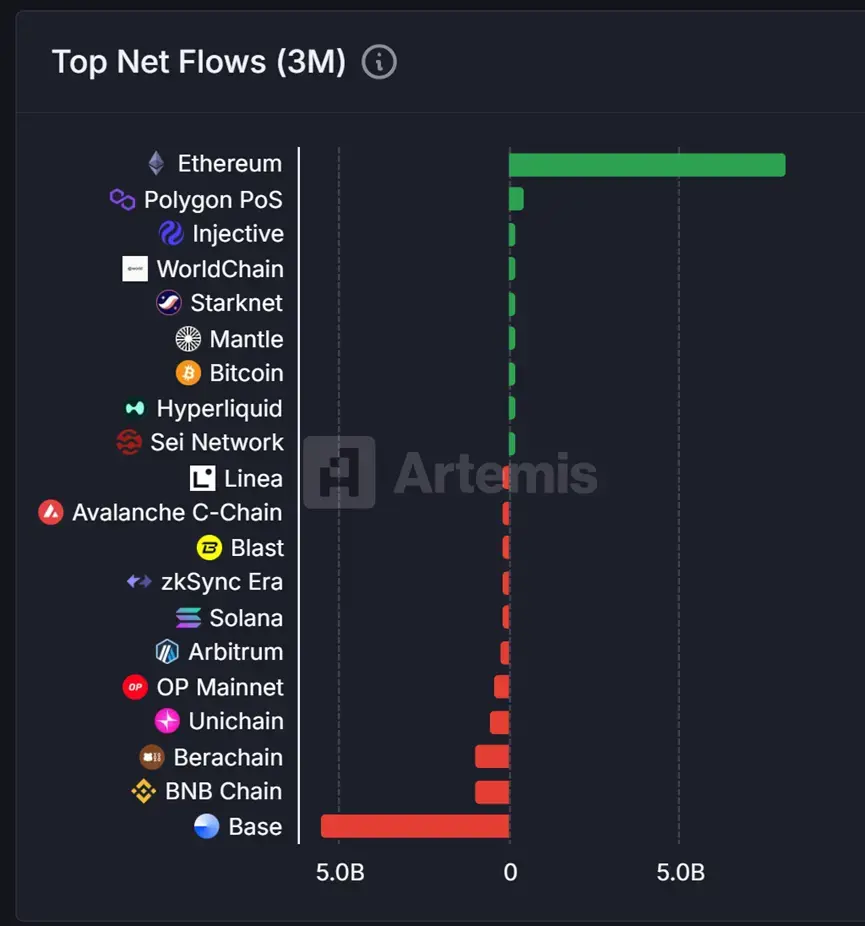Review of the performance data of 8 mainstream public chains in the past 3 months: Ethereum makes a comeback, Base and Hyperliquid data soar
Original author: Frank, PANews
Over the past three months, the crypto market has experienced a significant rebound. The performance of mainstream public chains has become the focus of the market, with Ethereum making a strong comeback under the dual boost of ETF funds and buying by listed companies. The prices of Solana, Sui, Hyperliquid, etc., have also risen sharply. From the price trend, the market seems to be entering a long-awaited altcoin season. But behind the prices, what is the actual development status of these public chains?

This article compiles the core indicators of 8 major public chains with high TVL amounts and popularity over the past three months—price, TVL, capital flow, on-chain activity, and ecosystem progress—to outline the real competition in this round of public chain racing. The data period is from April 20 to July 20.

Ethereum: The King's Return
In terms of daily active users and transaction counts on the chain, there were increases of 11.94% and 16% respectively over the past three months, without any particularly significant improvement. Additionally, Ethereum's spot ETFs showed significant growth during these three months, with a net increase of approximately $5 billion. Coupled with several U.S.-listed companies following MicroStrategy's lead by adopting Ethereum as a reserve token, this has provided more buying power and positive market sentiment for Ethereum. Overall, capital driving may be the main factor behind Ethereum's significant price increase.
Solana: The Leader in MEME Coin Issuance
TVL amount increased during this period, from $7.3 billion to $9.237 billion. In terms of performance within the ecosystem, Pump.fun remains the platform with the largest trading volume in the Solana ecosystem, contributing $234 billion in trading volume in the past month. Among the top DEXs, OKX DEX unexpectedly ranked in the top ten with a monthly trading volume of $4.6 billion.
In terms of MEME coins, Solana's current daily new token issuance is about 40,000 to 50,000, a significant drop from the 90,000 to 100,000 level in January this year. However, it remains relatively stable overall, without a cliff-like decline.
Currently, Solana's staking rate is about 66%, but it is evident that the number of validators is decreasing, which also means that large validators on Solana are gradually replacing small validators.
BSC: Alpha Activities Ignite On-Chain Revival
BSC's data effects seem completely opposite to Solana's. In terms of token price, BNB's change over the past three months is not very noticeable, rebounding nearly 30%. However, there has been significant growth in daily active users, transaction counts, and stablecoin issuance on the chain. First, the number of daily active addresses increased from 25.2 million to 44 million, up 74.6%; daily transaction counts grew from 7.85 million to 16.82 million, an increase of about 114%; stablecoin issuance increased from $7.12 billion to $11 billion, up 55%. From these data, BSC has seen relatively significant changes in the past three months, likely benefiting from the push of Alpha activities.
Although on-chain activity has increased significantly, in terms of capital inflow, BSC had a net outflow of $950 million over the past three months. How to convert the active users attracted by activities into settled funds may be a challenge BSC needs to solve next.
Base: High-Speed Expansion Fueling Ethereum
Base's on-chain data performance is also quite impressive, with TVL growing from $2.4 billion to $4 billion in three months, an increase of 63%. The number of daily active addresses increased from 15.6 million to 33.6 million, a rise of 115%, and daily transaction counts grew by 23%. Overall, Base's on-chain data has improved significantly, but there has been a large outflow of funds on the chain, with a net outflow of $5.6 billion over three months, making it the public chain with the most net outflow. Data shows that these funds ultimately flowed to Ethereum. Base has also become the largest source of funds for the Ethereum mainnet recently.
Additionally, Base chain launched Flashblocks technology, reducing block generation time from 2 seconds to 200 milliseconds, making it the fastest EVM chain currently. At the same time, Coinbase launched the Base App, creating a one-stop social and trading platform, which will further promote the development of the Base ecosystem.

Arbitrum: Steady Holding as the L2 Runner-Up
Overall, Arbitrum's data hasn't changed much, except for a 34% increase in TVL and a 22% increase in transaction counts. The number of daily active addresses has hardly changed, remaining at 4.6 million three months ago and now. However, ARB's price has rebounded by 66% recently, relatively strong among several major public chains. This may be due to the driving effect of Ethereum's price increase. Although Arbitrum's data hasn't changed much, it still firmly holds the second position among Ethereum L2s.
Sui: TVL and Token Price Both Soar
SUI's price has recently seen a significant increase, from $2.15 to a high of $4.24, a rise of 97%, nearly doubling. Behind this surge, there is some underlying data support. Mainly, TVL data increased from $1.2 billion in April to $2.2 billion, an increase of over 84%. Additionally, stablecoin issuance has exceeded $1 billion. In terms of daily active addresses, from May to June, Sui's daily activity experienced a roller coaster, first dropping from 1.5 million daily to 400,000 daily, then rebounding to around 1 million in early July. However, it has not yet returned to its previous peak.
Hyperliquid: Rocket-like Climb After Trust Crisis
Hyperliquid is almost the best-performing public chain in the past three months, with its token price soaring from $18 to $49.9, and its market value also breaking through $15 billion, ranking thirteenth among all tokens.
Reflected in on-chain data, TVL increased from $640 million to $1.943 billion, a rise of 202%. Stablecoin issuance increased from $2.1 billion to $4.9 billion, quickly becoming the fifth-largest public chain in terms of issuance. After the previous decentralization trust crisis, Hyperliquid's treasury HLP earnings have recently climbed again and exceeded $68 million, setting a new historical high. After entering July, Hyperliquid's daily new user count has risen again to over 3,000.
Aptos: The Lurker in Data Deceleration
Compared to other public chains, Aptos seems somewhat disappointing in terms of both on-chain data and price. The price rose by 10% in 3 months, while several key data points such as TVL, capital inflow, and daily active address count were negative. The biggest change may be a 34% increase in daily transaction counts and a $300 million increase in stablecoin issuance. Compared to Sui, which also uses the MOVE language, Aptos seems to be at a disadvantage in multiple data dimensions.
Overall, the recent performance of public chain data is not as intense as the market's reaction to token prices. Although, driven by the market, networks like Sui, Hyperliquid, and Base have also seen significant improvements in data, the extent of this improvement is clearly lower than the rise in token prices. Clearly, this is a recovery phase where capital precedes the ecosystem. Behind this recovery, whether the performance of token prices can translate into the prosperity of each public chain's ecosystem, and even drive practical application tracks like DeFi and chain games as in previous bull markets, may be the core factor in how long this altcoin season can last. Therefore, although current prices and on-chain data seem out of sync, in subsequent developments, these data may also become decisive factors for prices.
